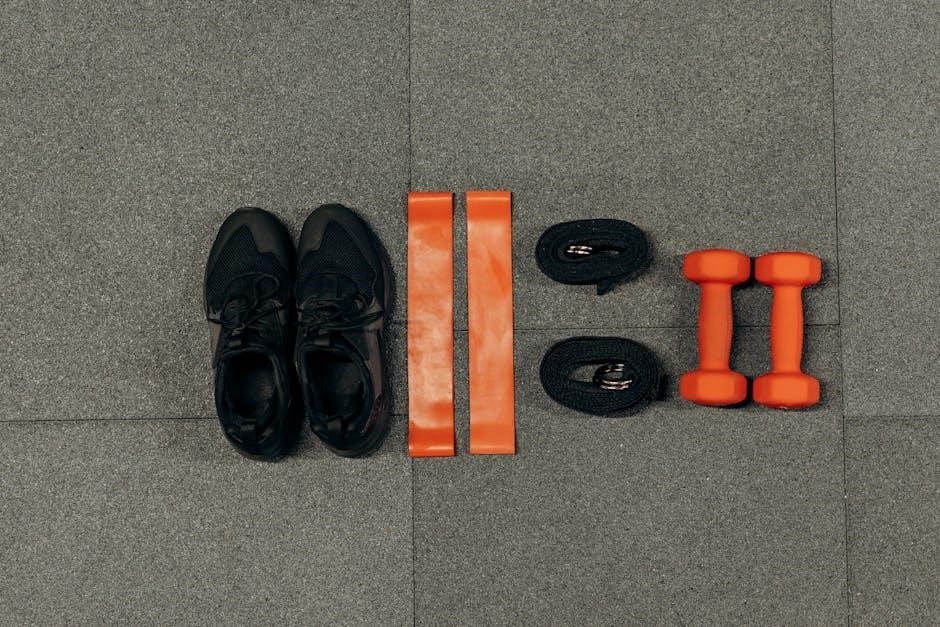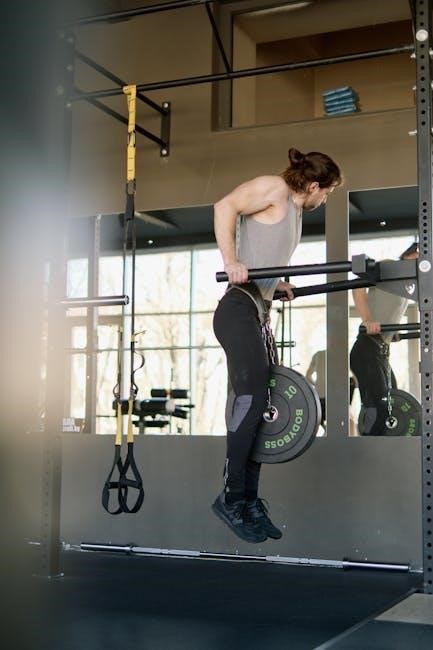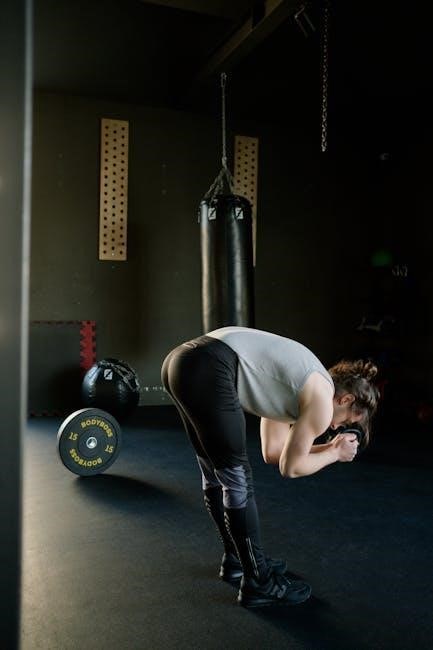
A well-structured weight training program is essential for maximizing softball performance‚ targeting leg strength‚ core stability‚ and upper body power to enhance endurance and explosive movements․
Overview of the Importance of Weight Training in Softball
Weight training is crucial for softball players as it enhances strength‚ endurance‚ and overall performance․ It strengthens muscles‚ connective tissues‚ and improves power‚ enabling better swings‚ throws‚ and sprints․ A structured program helps prevent injuries by building resilience in joints and muscles․ Additionally‚ it boosts stamina‚ allowing players to maintain peak performance throughout games․ Scientific research shows that consistent weight training leads to cellular adaptations‚ increasing muscle fiber efficiency․ Focusing on compound movements and progressive overload maximizes results․ A well-designed program tailored to softball-specific demands ensures players develop the necessary athleticism and durability for the sport․ This foundation is vital for both off-season and in-season success․
Benefits of a Structured Weight Training Plan for Softball Players
A structured weight training plan offers numerous benefits for softball players‚ including improved strength‚ power‚ and endurance․ It enhances muscle coordination‚ allowing for more explosive swings and throws․ A well-designed program increases speed and agility‚ critical for base running and fielding․ Additionally‚ it strengthens connective tissues‚ reducing injury risks․ Consistency in training leads to measurable performance gains‚ such as increased bat speed and pitching velocity․ Players also experience mental toughness and confidence boosts․ A structured plan ensures balanced development‚ addressing specific muscle groups and movement patterns․ This comprehensive approach prepares athletes for the demands of the game‚ fostering peak performance during competition․

Components of an Effective Softball Weight Training Program
A structured program targeting major muscle groups‚ incorporating exercises like squats‚ deadlifts‚ and plyometrics‚ with progressive overload to build strength and power for optimal performance․
Muscle Groups to Target
Effective softball weight training focuses on key muscle groups: legs for power and speed‚ core for stability‚ shoulders and back for throwing strength‚ and arms for bat control․ Leg exercises like squats and deadlifts build foundational strength‚ while core work enhances rotational power․ Shoulder and back exercises‚ such as rows and presses‚ improve throwing velocity and endurance․ Arm workouts‚ including bicep curls and tricep dips‚ support both batting and fielding․ A balanced approach ensures overall athletic performance‚ preventing imbalances and injuries․ Each muscle group is strategically targeted to enhance specific softball skills‚ creating a well-rounded athlete capable of excelling in all aspects of the game․
Key Exercises for Strength and Power
Essential exercises for softball strength include squats‚ deadlifts‚ and lunges for leg power‚ bench presses and incline presses for upper body strength‚ and rows for back endurance․ Plyometric exercises like box jumps and medicine ball throws enhance explosiveness․ Dumbbell swings and kettlebell exercises improve rotational strength‚ crucial for batting and throwing․ Inverted rows and pull-ups target the lat muscles‚ boosting throwing velocity․ Incorporating these exercises into a structured program ensures balanced development‚ enhancing overall performance on the field while reducing injury risk․ Proper form and progressive overload are key to maximizing results and achieving peak athletic conditioning․
Progressive Overload and Its Role in Training
Progressive overload is a cornerstone of effective weight training‚ involving gradual increases in intensity‚ volume‚ or frequency to challenge muscles and stimulate growth․ For softball players‚ this means gradually adding weight‚ reps‚ or sets to exercises like squats‚ deadlifts‚ and bench presses․ Over time‚ this approach enhances strength‚ power‚ and endurance‚ translating to improved performance on the field․ Consistent application of progressive overload ensures continued gains‚ helping players maintain peak conditioning and reduce injury risk․ It’s a critical strategy for achieving long-term athletic development and maximizing the benefits of a structured weight training program․

Sample 4-Day Weight Training Split for Softball Players
This structured program targets specific muscle groups daily‚ balancing strength‚ power‚ and conditioning to enhance overall softball performance and reduce injury risk through balanced development․
Day 1: Legs and Core
Day 1 focuses on building strength and endurance in the legs and core‚ essential for explosive movements and stability on the field․ Start with barbell squats (4 sets of 8 reps) to target quadriceps and glutes․ Follow with Romanian deadlifts (3 sets of 8-10 reps) to strengthen hamstrings and lower back․ Include inverted rows (3 sets of 10 reps) to engage the core and improve posture․ Finish with core-specific exercises like planks (3 sets of 30-60 seconds) and Russian twists (3 sets of 20 reps) to enhance rotational power and stability․ Progress to weighted variations as strength improves․ This routine ensures a strong foundation for softball performance․
Day 2: Shoulders and Back
Day 2 focuses on strengthening the shoulders and back‚ crucial for throwing‚ fielding‚ and overall upper body stability․ Begin with a barbell or dumbbell press (2 sets of 10 reps) to target the deltoids and triceps․ Follow with pull-ups or assisted pull-ups (3 sets of 8-10 reps) to build lat strength and improve posture․ Incorporate bent-over rows (3 sets of 8-10 reps) to engage the rhomboids and upper back muscles․ Finish with lateral raises (3 sets of 12-15 reps) to enhance shoulder mobility and endurance․ This routine helps improve throwing power and reduces the risk of shoulder injuries‚ essential for softball performance․ Progress by increasing weight or reps as strength improves․ Proper form is key to avoid injury and maximize results․
Day 3 emphasizes building chest and bicep strength‚ crucial for batting‚ throwing‚ and overall upper body power․ Start with flat bench presses (3 sets of 8-10 reps) to target the chest muscles․ Incline dumbbell presses (3 sets of 10-12 reps) help develop the upper chest and improve posture․ Move to bicep curls (3 sets of 10-12 reps) using dumbbells or a barbell to enhance grip and arm strength․ Finish with chest dips (3 sets of 12-15 reps) to engage the lower chest and triceps․ This workout enhances batting power and throwing velocity while improving overall upper body endurance․ Incorporate variations and progressive overload to continue building strength and muscle mass effectively․ Consistency and proper form are essential for optimal results and injury prevention․ Day 4 focuses on full-body conditioning to improve endurance‚ agility‚ and functional strength․ Begin with high-intensity interval training (HIIT)‚ such as burpees (3 sets of 10 reps) and jump squats (3 sets of 12 reps)‚ to boost cardiovascular fitness․ Incorporate medicine ball throws (3 sets of 15 reps) to enhance core power and explosiveness․ Add plank variations (3 sets of 30-second hold) to strengthen the core and improve stability․ Finally‚ perform agility drills like ladder exercises (3 sets of 30 seconds) to enhance speed and coordination․ This workout ensures overall physical preparedness‚ bridging the gap between strength training and on-field performance‚ while preventing overtraining by targeting multiple muscle groups simultaneously․ Proper hydration and nutrition are key to maximize results․ Consistency in this routine will yield noticeable improvements in game performance․ Always prioritize form to avoid injury and ensure effective muscle engagement․ Adjust the intensity based on individual fitness levels to maintain progress and avoid plateaus․ This comprehensive approach ensures that all aspects of physical fitness are addressed‚ making it an essential component of any softball training program․ By focusing on both strength and conditioning‚ players can achieve a balanced and robust physical foundation needed for peak performance․ Incorporate this workout once a week and gradually increase intensity as fitness levels improve․ Off-season training focuses on building strength and power‚ while in-season training maintains it with lower intensity to avoid overtraining‚ ensuring peak performance during games․ Training programs must adapt to the season’s demands․ Off-season focuses on building strength and power with higher intensity‚ while in-season prioritizes maintenance and injury prevention․ During preseason‚ emphasis shifts to explosive movements and sport-specific exercises․ Coaches adjust volume and intensity to avoid overtraining‚ ensuring players stay fresh․ For example‚ in-season workouts reduce heavy lifting‚ incorporating more plyometrics and core stability․ This balanced approach ensures peak performance during games while maintaining foundational strength․ Proper periodization is key to aligning training with the competitive schedule‚ optimizing results and reducing injury risks․ Proper nutrition and recovery are vital for muscle growth and performance․ A balanced diet‚ hydration‚ and techniques like stretching and sleep ensure optimal results in softball training programs․ Proper nutrition is fundamental for muscle growth and recovery in softball training․ A balanced diet rich in protein‚ carbohydrates‚ and healthy fats fuels muscle repair and energy production․ Protein sources like chicken‚ fish‚ and eggs aid in muscle repair‚ while complex carbs from whole grains provide sustained energy․ Healthy fats support hormone production‚ essential for muscle growth․ Adequate hydration is crucial for physical performance and recovery․ Timing meals around workouts ensures optimal nutrient absorption․ Avoiding processed foods and maintaining a caloric surplus supports muscle gain․ A well-planned diet complements weight training‚ enhancing strength and endurance for peak softball performance․ Nutrition is a cornerstone of successful muscle growth and athletic success․ Recovery is vital for enhancing performance in softball weight training․ Techniques like stretching‚ foam rolling‚ and ice baths help reduce muscle soreness and improve flexibility․ Active recovery‚ such as light cardio or yoga‚ promotes blood flow without overexertion․ Adequate sleep is crucial‚ as it allows muscles to repair and rebuild․ Additionally‚ compression garments and massage can aid in reducing muscle tension․ Proper recovery strategies ensure athletes can train consistently‚ reduce injury risk‚ and optimize their performance on the field․ Incorporating these methods into a routine supports overall athletic development and longevity in the sport․ A well-structured softball weight training program enhances strength‚ endurance‚ and performance while reducing injury risks․ Consistency and dedication are key to achieving long-term success and peak athletic potential․ Consistency is key; stick to your program and track progress․ Focus on compound exercises like squats‚ deadlifts‚ and presses for overall strength․ Gradually increase weights to avoid plateaus․ Prioritize proper form to prevent injuries․ Incorporate core and conditioning work for stability and endurance․ Ensure adequate nutrition‚ with sufficient protein to support muscle growth․ Recovery is crucial—use techniques like stretching‚ foam rolling‚ and rest days․ Stay hydrated and get enough sleep to optimize results․ Adjust the program seasonally‚ intensifying during the off-season and maintaining during the season․ Set realistic goals and celebrate small achievements to stay motivated․ A well-rounded approach will yield the best outcomes for softball performance․Day 3: Chest and Biceps
Day 4: Full-Body Conditioning

Off-Season vs․ In-Season Training
Adjusting the Program for Different Phases of the Season

Nutrition and Recovery for Optimal Results
The Role of Proper Nutrition in Muscle Growth
Recovery Techniques to Enhance Performance
Final Tips for Implementing a Successful Weight Training Program